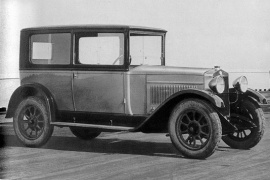FIAT 509 Models/Series Timeline, Specifications & Photos
First production year: 1925
Engines: Gasoline
Introduced in 1924 as a replacement for the Fiat 501, the 509 model became one of the most important vehicles in the Italian automaker’s history after it won the Monte Carlo Rally in 1928.
In the mid-20s, most cars were considered expensive toys for rich people. Slowly but surely, some automakers started to lower their vehicles’ prices to become attainable by the mid-class customers. When Benito Mussolini’s fascist party took power in Italy in 1922, he forced Fiat to produce vehicles for the masses. As a result, the automaker introduced the affordable 509 at the 1924 Automobile Paris Salon. Even though it was mostly a scaled-down version of other larger Fiat vehicles, it could still carry four adults inside in comfort. In addition, the Italian automaker offered the car with several bodywork options.
During those times, most automakers chose to provide customers with rolling chassis, ready to be completed by custom coachbuilders. Fiat considered that it could do a better job and delivered its vehicles ready to run. At the front, the 509 featured a flat radiator adorned by a brass surrounding and a roof-like top sporting a filler cap. The short but curved wheel arches supported the electric headlights, which was uncommon for low-budget cars. Since the car didn’t have a bumper, the extended leaf springs peaked out in front of the vehicle.
From its sides, the 509 showed angular shapes and flat panels, which were cheaper to produce. The engine compartment featured side-mounted opening panels that sported cooling louvers. Fiat installed side steps connecting the front and rear fenders to help with the ingress and egress of the passengers. Depending on the options, customers could get the 509 from the factory in several bodywork options, such as the sedan, the four-door convertible (torpedo), or a two-seat roadster. The 509’s short wheelbase forced the automaker to install the spare wheels in the back, behind the trunk.
Inside, the automaker installed two rows of bench seats for most versions. The driver fronted a four-spoke steering wheel and a flat windshield. Fiat placed several dials on the dash panel, and the side passenger fronted a clock and a few additional gauges for the coolant temperature and the fuel level. Fiat added a second bench in the back that could host two passengers. Still, the automaker offered a few luxurious options, such as leather upholstery.
Despite being a mass-market vehicle, it was well-equipped. Fiat made it with a 12-volt electrical system, drum brakes in all corners, and semi-elliptic leaf springs for both axles mounted under the chassis. Under the hood, the Italian automaker installed a single overhead camshaft one-liter engine paired with a three-speed manual that sent its power to the rear wheels via a driveshaft, not a chain. Thanks to its low price and financing options, the 509 became a huge success. The Italian automaker sold about 90,000 units before 1929, when Fiat replaced it with the 508 Balilla.
